
Airfix 1/72 MiG-15bis
| KIT #: | A02037 |
| PRICE: | $ |
| DECALS: | Three options |
| REVIEWER: | Martin Pohl |
| NOTES: | New tool kit |

| HISTORY |
The Mikoyan-Gurevich MiG-15 was a jet fighter developed for the 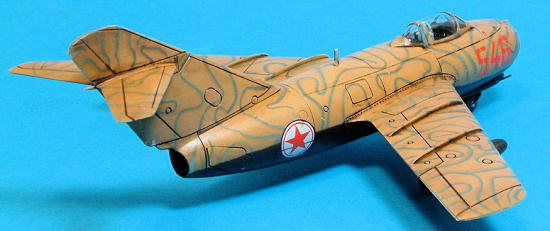 North
American F-86 Sabre in lists of the best fighter aircraft of the Korean War and
in comparison with fighters of other eras.
North
American F-86 Sabre in lists of the best fighter aircraft of the Korean War and
in comparison with fighters of other eras.
Most early jets were designed like piston-engined fighters with straight wings,
limiting their high speed performance. German research during World War II had
shown swept wings would perform better at transonic speeds, and Soviet aircraft
designers were quick to take advantage of this information. There are claims of
Artem Mikoyan and Mikhail Gurevich (lead designers of the "MiG" bureau) being
heavily influenced by the Focke-Wulf Ta 183. The abortive late-war German jet
had swept wings and bore a resemblance to the later MiG-15, but the two aircraft
are different in structure and general design. The Soviets did seize plans and
prototypes for the Ta-183, but the majority of Focke-Wulf engineers (in
particular, Hans Multhopp, who led the Ta-183 development team) were captured by
Western armies; therefore, it could be argued that the MiG-15 design team drew
some limited inspiration from the Ta-183, but there is insufficient evidence to
prove it was heavily influenced. Currently, many sources claim that the MiG-15
is an original design benefiting from German research, but conceived, designed,
engineered, and produced by the Soviets.
(source: Wikipedia)
| THE KIT |
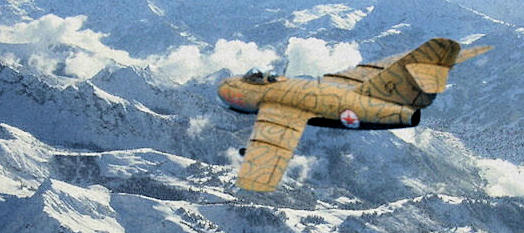 The new
tooling Airfix Kit of the Fagot comes in three sprues plus one for the clear
parts. The moldings are nice with panel lines a bit wide and deep to my taste.
The surface of the parts is a bit rougher than one would expect from a new
tooling, but it looks good in the end. The only minus I could find were some
ejector pin marks which are at places where they could be seen, especially on
the inside of the gear doors.
The new
tooling Airfix Kit of the Fagot comes in three sprues plus one for the clear
parts. The moldings are nice with panel lines a bit wide and deep to my taste.
The surface of the parts is a bit rougher than one would expect from a new
tooling, but it looks good in the end. The only minus I could find were some
ejector pin marks which are at places where they could be seen, especially on
the inside of the gear doors.
The instructions are very good with extra pages for colors and markings printed
in color.
| CONSTRUCTION |
For this new tooling Mig-15 I can't say much, I just followed the instructions.
It almost felt together and I did not use any filler. This may be because I used
extra thin cement and a good pressing, this way I only had to sand away some
excess.
I did not add any extras this is just an out of the box build.
| COLORS & MARKINGS |
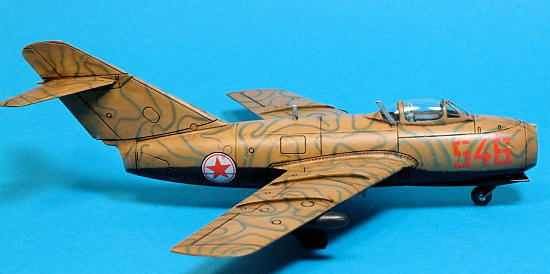 I
decided to do the North Korean version with this “spaghetti” camouflage scheme.
If you look at that scheme the first which comes to mind is – wow all that free
hand lines on that small plane. Well I do airbrush for quite a while now and I
know my hands are steady enough to do this freehand, so the painting followed
these steps: first a coat of silver at the cockpit entrance area and the side
walks; then some salt there. My second try on the salt method. I'm still not
sure if that method really is worth the effort, but then it could just be me.
After that a complete coat of a self mixed green tone followed. This green looks
like a lighter olive drab. Then the masking with “spaghetti” – no not really
noodles but something similar. I rolled blue tack or in my case yellow tack very
thin, as thin as spaghetti and laid those on top of the green. Then a sand tone
on top of that was sprayed. After removing the tack-spaghetti it just looked
what I
I
decided to do the North Korean version with this “spaghetti” camouflage scheme.
If you look at that scheme the first which comes to mind is – wow all that free
hand lines on that small plane. Well I do airbrush for quite a while now and I
know my hands are steady enough to do this freehand, so the painting followed
these steps: first a coat of silver at the cockpit entrance area and the side
walks; then some salt there. My second try on the salt method. I'm still not
sure if that method really is worth the effort, but then it could just be me.
After that a complete coat of a self mixed green tone followed. This green looks
like a lighter olive drab. Then the masking with “spaghetti” – no not really
noodles but something similar. I rolled blue tack or in my case yellow tack very
thin, as thin as spaghetti and laid those on top of the green. Then a sand tone
on top of that was sprayed. After removing the tack-spaghetti it just looked
what I 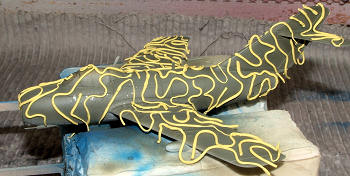 was
hoped. Then followed the masking for the underside and a super dark brown
coating. I just did not want it all black.
was
hoped. Then followed the masking for the underside and a super dark brown
coating. I just did not want it all black.
A Future coat before the decals and then I sprayed the white areas for the
insignias cause my references showed white based North Korean red stars and the
decals did not provide the white base they were clear. I'm still not sure if
that was the right decision but it looks better this way – well at least for me.
After a last future coat some weathering and a semi flat coat ended it. For
weathering I used some dark brown wood paint on top and black on the underside.
| CONCLUSIONS |
It is a real nice representation of the Mig-15 that’s sure and it’s a nice
little kit for a small project for in between. There are tons of possibilities
to paint a Fagot, so to get one is always worth it.
| REFERENCES |
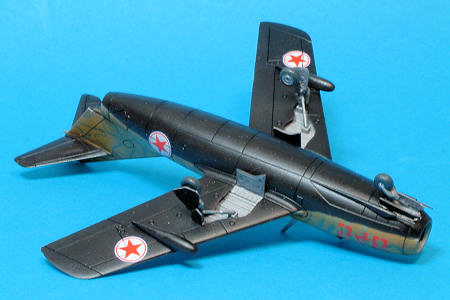 As always
the internet and for scheme research those books:
As always
the internet and for scheme research those books:
Warbird Tech Mig 15 Fagot
Walk Around Mig-15 Fagot
Soviet Mig-15 Aces of the Korean War
Martin Pohl
March 2012
If you would like your product reviewed fairly and fairly quickly, please contact the editor or see other details in the Note to Contributors.